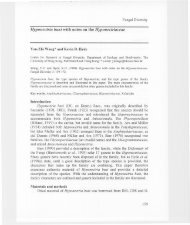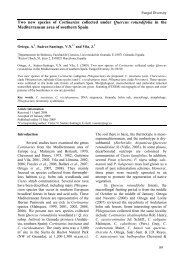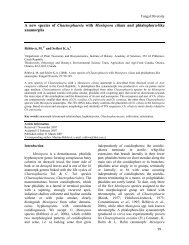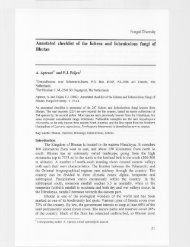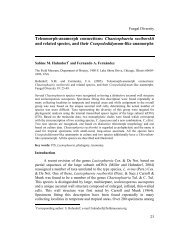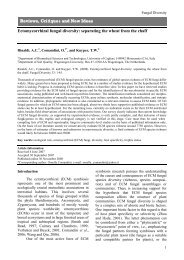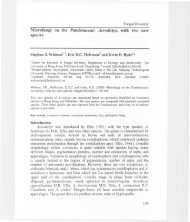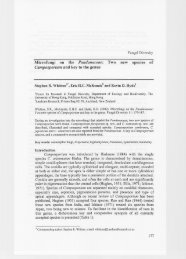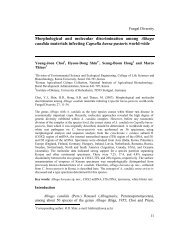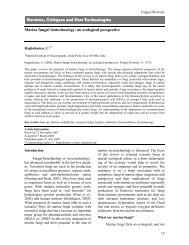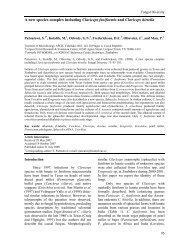Fungal spores in rainwater: stemflow, throughfall ... - Fungal diversity
Fungal spores in rainwater: stemflow, throughfall ... - Fungal diversity
Fungal spores in rainwater: stemflow, throughfall ... - Fungal diversity
You also want an ePaper? Increase the reach of your titles
YUMPU automatically turns print PDFs into web optimized ePapers that Google loves.
submerged litter and how this spore <strong>in</strong>put affects the species composition of<br />
the hyphomycetes <strong>in</strong> these habitats is not known.<br />
3. The present study provided little evidence of active existence of<br />
aquatic hyphomycetes on live trees. Quite a few species, however, e.g.<br />
Camposporium pellucidum, Diplocladiella scalaroides, Lateriramulosa uni<strong>in</strong>flata,<br />
Tr<strong>in</strong>acrium spp., Tripospermum myrti, of which conidia are regularly<br />
found <strong>in</strong> stream habitats, usually as rare species, proved to be widely<br />
distributed fungi <strong>in</strong> ra<strong>in</strong>water from live trees even <strong>in</strong> a polluted urban<br />
environment. Their common occurrence <strong>in</strong> the phyllosphere <strong>in</strong>dicates that they<br />
probably do not belong to the true aquatic fungi.<br />
4. The growth habits of the fungi of which conidia were recovered <strong>in</strong> a<br />
ra<strong>in</strong>water sample, on live trees <strong>in</strong> most cases are not known. Pestalotiopsis<br />
guep<strong>in</strong>ii is generally restricted to live or recently killed wood (Bills and<br />
Polishook, 1991). The majority of the species discussed <strong>in</strong> this study are<br />
known as plant litter <strong>in</strong>habit<strong>in</strong>g species. We found, however, that some of them<br />
may occur on the trunk, and possibly on other parts of the trees. Although we<br />
have collected them from live trees it became evident that, for example,<br />
Camposporium cambrense and C. ontariense grew and sporulated heavily on<br />
the cortex of platan. Arxiella terrestris, C. japonicum, C. pellucidum,<br />
Diplocladiella scalaroides, Endophragmiella taxi, Excipularia fusispora,<br />
Oncopodiella trigonella, Triadelphia heterospora and T. uniseptata which are<br />
primarily known as wood or leaf litter <strong>in</strong>habit<strong>in</strong>g species may also live on and<br />
come from dead parts of the live trees. The term "litter" is conventionally used<br />
for dead plant material deposited on the ground or <strong>in</strong> various water bodies. The<br />
results <strong>in</strong> this study, together with other observations, suggest that many of the<br />
litter <strong>in</strong>habit<strong>in</strong>g fungi may colonize their substrates earlier than those are fallen<br />
to the ground. Carroll (1981) also discussed, ma<strong>in</strong>ly <strong>in</strong> Douglas fir canopy, the<br />
role of "canopy fungi or arboreal aquatic hyphomycetes <strong>in</strong> the decomposition<br />
of litter lodged <strong>in</strong> the canopy". In his op<strong>in</strong>ion "such fungi constituted a guild of<br />
arboreal aquatic hyphomycetes which may function <strong>in</strong> canopies much as<br />
classical Ingoldian aquatic hyphomycetes function <strong>in</strong> streams". The abundance<br />
of the conidia and the richness of the species <strong>in</strong> ra<strong>in</strong>water from trees, observed<br />
dur<strong>in</strong>g this study, <strong>in</strong>dicate that these fungi may have an important role <strong>in</strong> the<br />
canopies. This phenomenon requires much further study because we know<br />
much less about hyphomycetes decompos<strong>in</strong>g litter <strong>in</strong> the canopy than those<br />
which act <strong>in</strong> aquatic or terrestrial habitats (litter on the ground).<br />
84



